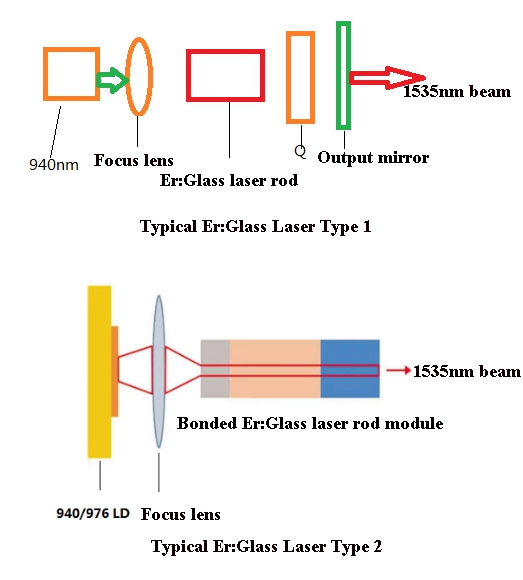●Co:Spinel (Co2+:MgAl2O4) bonding as passive Q-Switch
● Wavelength of laser:1535nm
● Concentrations: 0.25~1.3
● Cross section for stimulated emission:0.8
● Fluorescent lifetime (ms):9.4-9.8
Although most solid-state lasers consist of a number of discrete elements (e.g. of a laser crystal or glass, some laser mirrors, and possibly additional intracavity optical elements), there are some types of lasers which are monolithic. For monolithic lasers according to a strict definition, the whole laser resonator consists only of some piece of crystal or glass. The resonator is then closed either with dielectric mirror coatings on the surfaces, or with total internal reflection. A somewhat relaxed definition allows for reflections from additional optical elements, and even for additional components within the laser resonator, provided that these elements are rigidly attached (e.g. bonded) to the gain medium.
There are monolithic lasers of different kinds; some typical examples are listed in the following:
Microchip lasers have a linear resonator, with the gain medium being a thin slice of crystal or glass material. Such lasers are available as compact single-frequency lasers, also in Q-switched form or with intracavity frequency doubling (→ green lasers).
Nonplanar ring oscillators (NPROs) are monolithic lasers where the laser radiation circulates along a nonplanar ring in a single laser crystal (e.g. of Nd:YAG). In most cases, these are single-frequency lasers, and they can deliver up to a few watts of output power.
Waveguide lasers are also often monolithic. Such a laser can be based on, e.g., a channel waveguide in lithium niobate (LiNbO3). The nonlinearity of this material allows for further functions, such as electro-optic modulation for Q switching, mode locking, or wavelength tuning.
Fiber lasers are also often called monolithic when all fiber components (for example, a fiber coupler, a gain fiber, a fiber-coupled pump laser diode and two fiber Bragg gratings as end mirrors) are spliced together, such that the laser becomes alignment-free.
Most semiconductor lasers, e.g. laser diodes, are monolithic.
There are two typical types of Er:Glass lasers,one is using laser rod/slab as active element and Q-Switch seperately,another is using bonded Er:Glass to get gain medium,Q-swith and output coupler as a whole,say,monolithic microchip laser, which present advantages of easy fixing and stable architechures.We supply series of such active element modules for microchip laser transmitter design for output pulse energy 100uJ,200uJ,300uJ,4000uJ,500uJ etc...with repetition rate 1-10Hz adjustable, and 40uJ with repetition rate 1kHz(1000Hz) .As we know,Co:Spinel ( Co2+:MgAl2O4) ) is ideal material of passive Q-Switch for 1535nm laser, so we bond Er 3+,Yb3+:Phosphate glass and Co2+:MgAl2O4 together as a whole composite gain medium module with necessary optical coatings as required for better structured microchip DPSS lasers,which is a way for us to deeply join in clients designing microchip lasers.KITS of active element,LD pump laser and collimating lens as well as 25X or 35X beam expander,Narrow band filter@1535nm,T>9 0% can be supplied as required when necessary.

OEM composite microchip laser gain modules and waveguides for secific applications can be customized as given drawings required.
Contact: John Jay Woo
Phone: +86-13982280204
E-mail: digco(at)digco-techs(dot)com
Whatsapp:+86-13982280204
Add: No.2339,South Secrion of Tianfu Avenue,Tianfu New Area,Chengdu 610213,China
We chat
